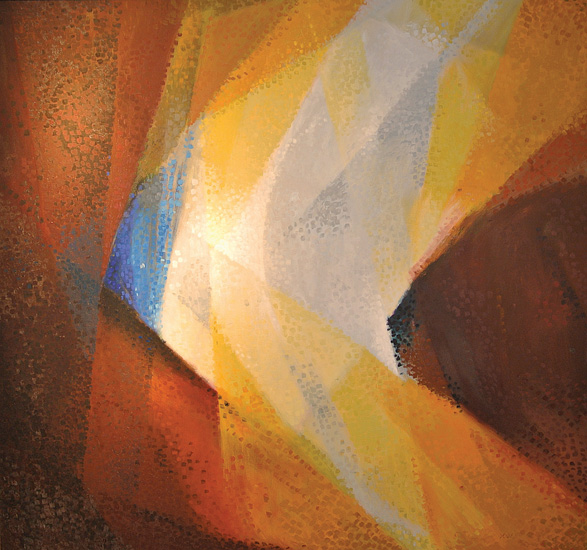 |
||||||||||
Jack Wright: A Unified Theory of Painting |
SCROLL RIGHT AND DOWN FOR MORE IMAGES | |||||||||
Jack Wright hailed from the Midwest, came to California in 1950, and soon became part of an avant-garde circle of artists living mostly in Marin County that formed around the British Surrealist Gordon Onslow Ford. Wright and other members of this group sought the visionary through the act of painting itself and were inspired by Surrealist automatism, Eastern calligraphic forms, and close observation of nature. Wright’s technique is characterized by his distinct square pointillist mark, which the artist used to create waves, lines, and portent shapes in gradations of rich, saturated color. These individual dot forms are often interwoven with sharp, curving arcs and energetic calligraphic squiggles that channel and emulate light itself. As these dots and lines wash over his canvases—which are often large, even mural-sized—the effect is one of shimmering vibration moving across the surface. Simultaneously, the layers of color and pattern extend the perceived depth of the painting as well. Wright’s paintings were shown throughout the years at various galleries and museums including the Walker Art Center, Betty Parsons Gallery, the Minnesota Museum of Art, at the Lucid Art Foundation, and in a one-man show at the Everson Museum of Art. Nonetheless he mostly, and happily, worked in an isolated studio near Point Reyes, paying little attention to the public display of his art. It was this seclusion that allowed Wright years of concentrated work, in which he was able to create his own unified theory of painting—one that invokes simultaneously Russian constructivism and Aboriginal sand painting, Light and Space and Abstract Expressionism, Viennese expressionism and anonymous graffiti, the mundane drip of world news and the profound flow of nature, quantum physics, and Native American spiritualism. He gives us the view to all of these at once; the divisions disappear. His friend and associate Onslow Ford aptly wrote that, “Wright’s paintings have moved through the surface and into an inner-world beyond . . . these pioneering paintings are playing a part in creating a more inclusive way to SEE.” Likewise, perhaps at the heart of Jack Wright's painting was his ability to really observe, get at, and bring together the large and the small simultaneously in a single canvas. Wright approached his work both from within, as a scientist might, understanding each brushstroke at a individual, micro level, and also as a surveyor, able to see the entire landscape of the canvas and its place in a larger context. The effect is somatic and provides us with an intuitive way to navigate the small path in front of us as we also seek the divine.
Jack Wright: A Unified Theory of Painting has been organized by Travis Wilson of Wilson Art Service and Jasmine Moorhead of Krowswork. A previous incarnation of this exhibition, with a different, though overlapping selection of works appeared at the Lucid Art Foundation and was organized by the Wright family and Dr. Fariba Bogzaran, and took place from October 2013 to March 2014. A catalogue, edited by Jasmine Moorhead and with an essay by Travis Wilson, was published to accompany that exhibition. The essay by Travis follows below. |
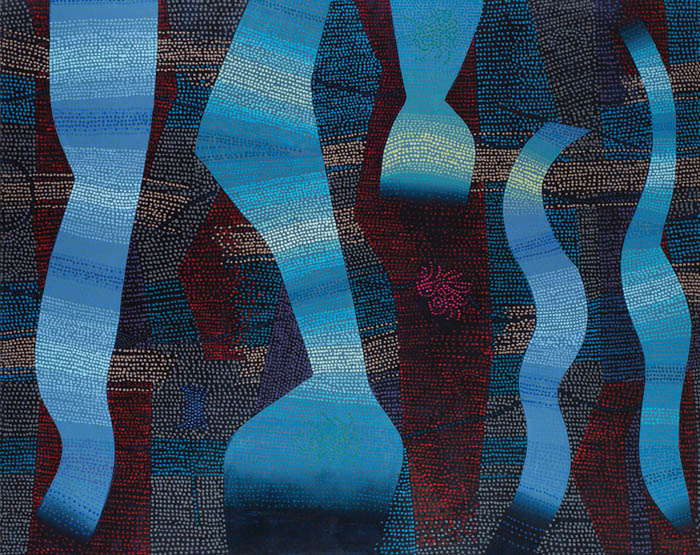 Jack Wright. Group of Five. 1984. Oil on canvas, 91 x 114 inches. |
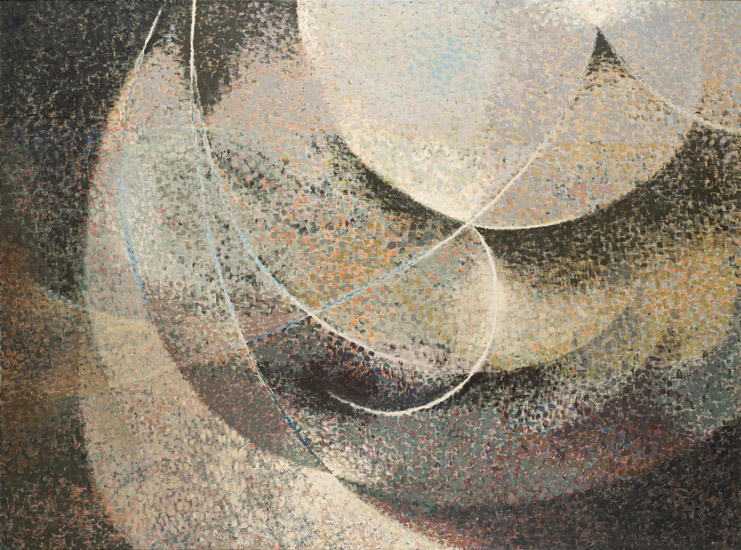 Jack Wright. Cloud Chamber. 1952. Oil on canvas, 42 3/8 x 57 1/4 inches. |
 Jack Wright. Group of Seven. c.1977.Acrylic on canvas, 34 x 48 inches |
|||||||
 Jack Wright. Red God. 1979. Acrylic on canvas, 91 x 114 inches. |
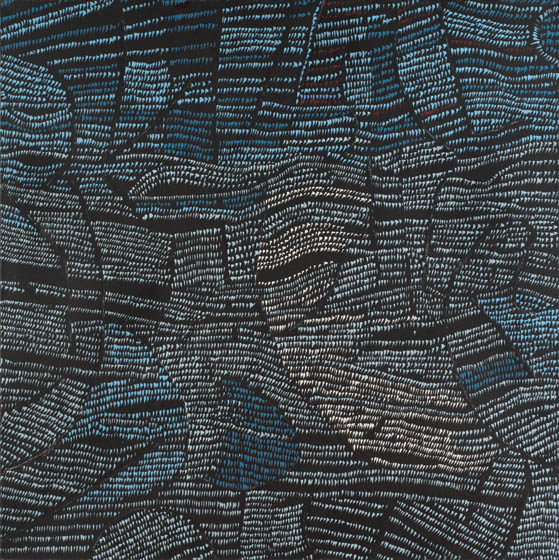 Jack Wright. Untitled. 1970. Acrylic on canvas, 48 x 48 inches. |
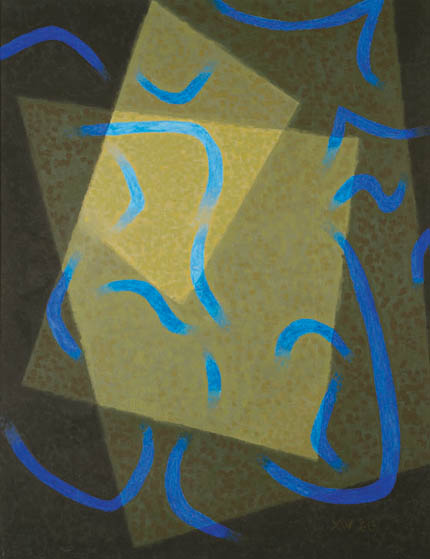 Jack Wright. Little Blue Demon of the Woods. 1960. Oil on canvas, 37 3/4 x 29 1/2 inches. |
||||||||
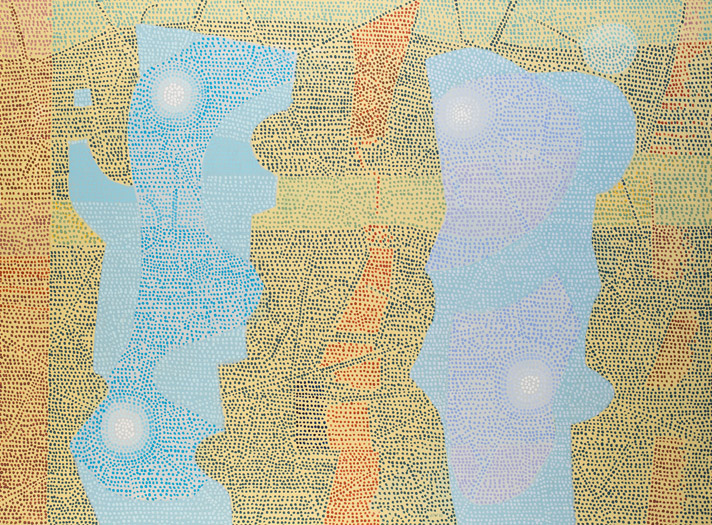 Jack Wright. Untitled. 1983. Acrylic on canvas, 54 x 72 inches |
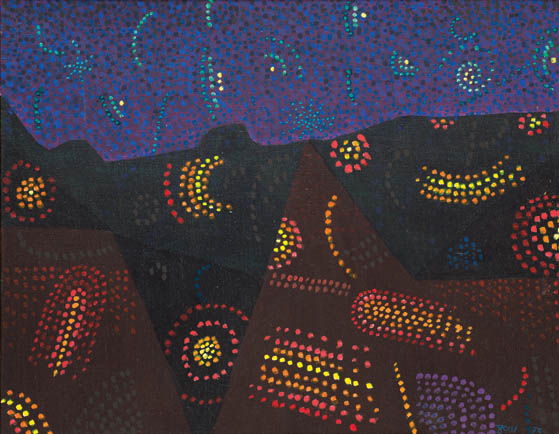 Jack Wright. A Night in Sedona. 1973. Acrylic on canvas, 15 x 19 inches |
 Jack Wright. Metamorphosis. 1982. Acrylic on canvas, 19 x 19 inches |
||||||||
|
||||||||||
JACK WRIGHT: LUMINOUS VISIONS by Travis Wilson
At first glance the work of Jack Wright presents a mystery. He gives you enough initial information to pique your curiosity and lure you in for a closer look, but the paintings don't readily give away their deepest secrets. Instead, they make a compelling visual case to bring yourself to them, that you, the viewer, should be truly present to receive them. It is only in this state of mind that one begins to really see the works. Up to a point Wright worked like a scientist, carefully considering every element of light, color, depth, and composition until each painting worked in perfect harmony. But then it is clear that the deference to a scientific order stops, and a profound artistic vision takes over. The art begins to vibrate in a way that is almost musical, and you must abandon the mere visual clues and allow yourself to feel how the artist passionately conducted each mark and movement in his work, as if they were notes of a symphony. This exhibition showcases fifty years of Wright's work, where one can not only examine individual master works but can begin to understand the subtle outlines of his lifelong evolution as a painter. Each phase of his career added a new component while refining those that already existed—a slow build within each individual opus but also over the entire arc of his career. This exhibition presents a rare opportunity to see such a pristine body of work that spans a lifetime, and rarer still to see one of such meaning and quality. John "Jack" Cushing Wright's career as an artist mirrors the growth of American culture that came to prominence after World War II. Born in St. Paul, Minnesota, in 1919, he showed the inclination to be a painter at an early age. This was galvanized when he studied with the painter Cameron Booth at the St. Paul School of Art in the late 1930s. Booth introduced him to modernism and the work of Giorgio de Chirico, Eugene Berman, Pablo Picasso, Paul Klee, and Henri Matisse. Booth's combination of art historical instruction and personal guidance helped pave the way to Wright's artistic devotion and open-minded ideas based on personal liberty and individual expression. He saw the possibilities that being an artist could offer him and experienced the freedom that comes with independent forethought. These early years expanded his horizons and set a lofty standard for his own artistic pursuits. Wright's life was marked by a series of pivotal moments, each of which inexorably altered the course of his development. He termed them his "gong" moments. One of these moments came to him while walking through the collection of the Art Institute of Chicago, where he encountered a painting by Morris Graves. The young artist had a deep emotional reaction to a piece of art for the first time. This experience solidified his drive to be a painter and crystallized his desire to explore the great realms of the unknown. It gave him a glimpse of the vast spaces of the inner worlds that had been previously hidden from him. Wright joined the Army in 1942, and in 1945 he married the painter and future ceramicist Patty Ordway, a partnership that would endure the rest of their lives. The Wrights moved their young family to Northern California in 1950, seeking the open-minded ideals that epitomized the Bay Area and which better mirrored their own. They settled in Marin County, and Jack worked as an architectural color consultant while still actively painting. In time the family grew to four sons. In this period he was also making inroads into the art world, having regular shows and exhibitions at such venues as the Walker Art Center and Minneapolis Institute of Art. Then, in 1948 his work was shown at the Betty Parsons Gallery in New York, one of the leading avant-garde galleries of its day. In 1952 Wright made one of his first pointillist paintings. This would prove to be another crucial moment in his life. Although stylistically it was realistic, this work hinted at the abstraction and spiritual undertones to come. The image of two pieces of fruit sitting alone in front of a vast mountain range evokes the ethereal, almost surreal, weightlessness that would later define his work. The pointillist style would evolve into the large scale abstractions for which he was best known. Within a year of this breakthrough, this evolution to his mature style began in earnest with works like Cloud Chamber. With its undulating matrix of soft dots and linear foundation this large canvas would in many ways become the archetype for the next half century's production. Its title suggests particle physics, the study of magnetism, and other mysterious universal forces, while its subtle use of color and line denotes the gently curving paths of the unseen world around us. However, this painting quickly transcends science, manifesting instead the inarguable truth of our collective relationship with nature and spirituality by illustrating the shared visual language of the two. Wright somehow combines factual nature with theological creation. Another of the pivotal moments in Wright's growth came in the mid-1950s when he met the English painter Gordon Onslow Ford, who had been one of the original members of the Parisian Surrealists. He had served as an officer in the Royal Navy and came to the United States in 1940 as an emissary of European culture; he was tasked to give a series of lectures on Surrealism at the New School for Social Research in New York, which would prove to have a far a reaching effect regarding the transition of the art world from Europe to the United States during World War II. After that he lived in Mexico for several years and finally settled in the Bay Area by 1947. Jack's relationship with Gordon would influence his work and refine his thinking about art's purpose and production; he was introduced to lucid dreaming and benefited greatly from Gordon's immense experience as an artist.Through Onslow Ford, Wright was also introduced to a group of painters and sculptors with whom he would go onto collaborate for decades to come. John Anderson, J.B. Blunk, Richard Bowman, Fritz Rauh, and Lee Mullican, along with Onslow Ford, would form a veritable "lost school" of California artists. The shared vision and collaborative efforts of these artists led to a group that made art without boundaries and limitations. As a result, they accomplished some of the most thorough visual research on consciousness from the perspective of visual artists done in the last century. It is only now that the public at large is being exposed to their conclusions. They acted as pioneers, forging a new direction unrestricted by the need to make gallery friendly art. This created a culture of creative purity: this group that existed on the pristine ridges and mountainsides of Marin County worked far away from the commercial demands of the art world and its accompanying anxious quest for fame. They did it because they had a need, a drive, an insatiable itch that had to be scratched, like a traveler who must see what is around the next bend in the road. The paintings of Jack Wright can also be read as portals and gateways. There is a special vitality in his work from this period—a sense of being pulled in and led to a place of weightless clarity. Large-scale pieces made up a significant amount of Wright's late oeuvre, some as big as 18 x 12 feet. The benefits of working on such a scale are evident when you look at the encompassing complexity of pieces such as Group of Five from 1984 . At first glance this piece appears to be as much woven as it is painted. The shifting patterns of subtle blues seamlessly transition into richer undertones. The lighter shapes then dance to the foreground and evoke transparent figures swaying rhythmically like treetops in a gentle breeze.
|
Krowswork Installation Views |
|
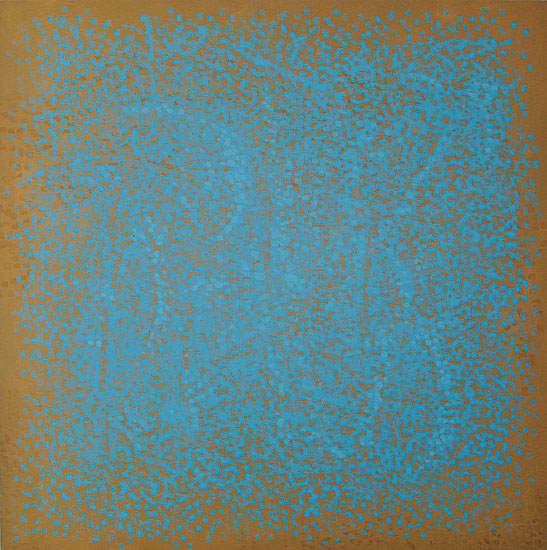 Jack Wright. Untitled. 1978. Acrylic on canvas, 50 x 50 inches |
|||||||
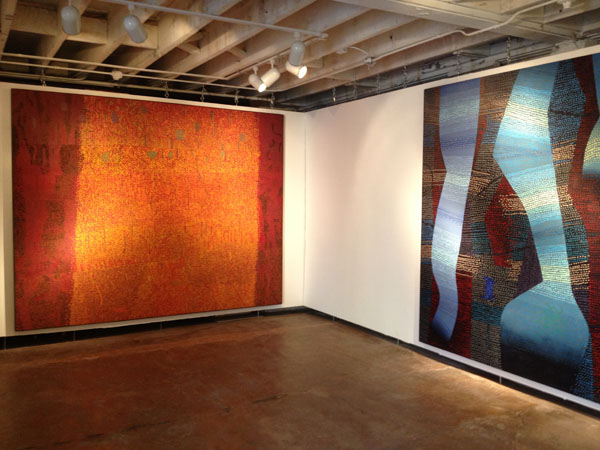 |
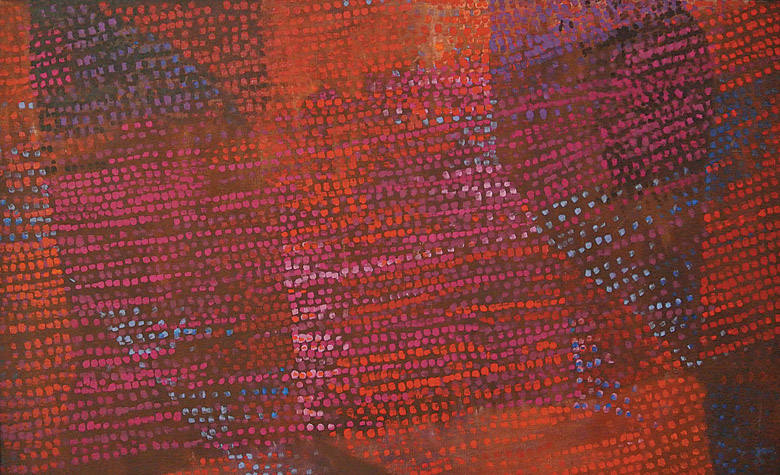 Jack Wright. Untitled. 1964. Oil on canvas, 30 x 48 1/4 inches |
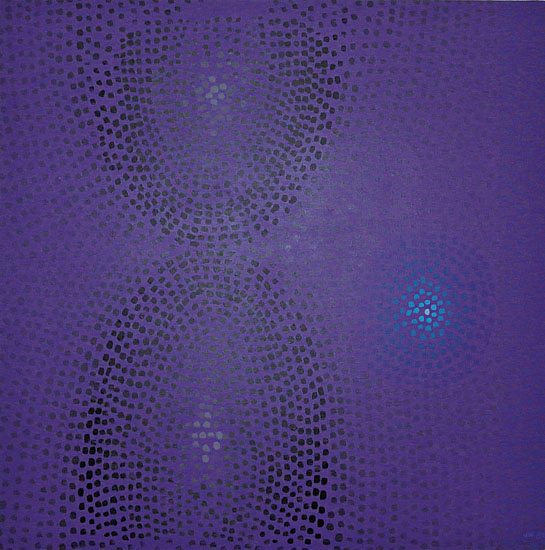 Jack Wright. Bruja. 1982. Acrylic on canvas, 40 x 40 inches |
||||||||
 |
 Jack Wright. Continuum. 1989. Acrylic on canvas, 66 1/2 x 50 inches |
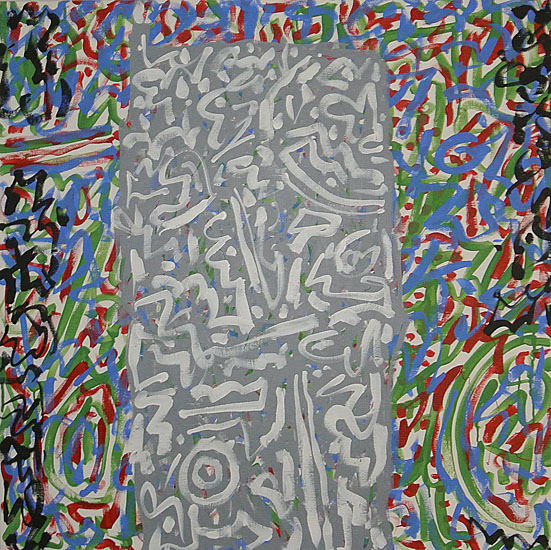 Jack Wright. Untitled. 2001. Acrylic on canvas, 36 x 36 inches |
||||||||
 |
 Jack Wright. Untitled. 1968. Acrylic on canvas, 48 x 48 inches |
|||||||||
 |
||||||||||
|
||||||||||

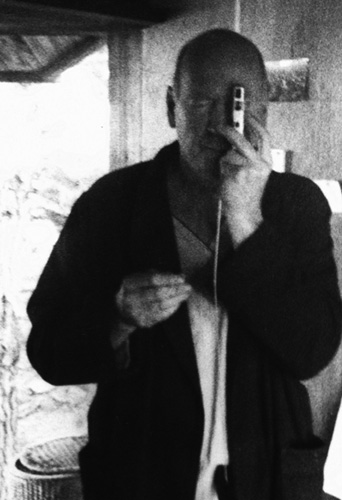 Jack Wright. Self-Portrait. c. 1975
Jack Wright. Self-Portrait. c. 1975